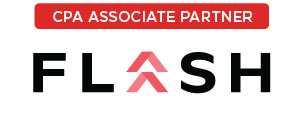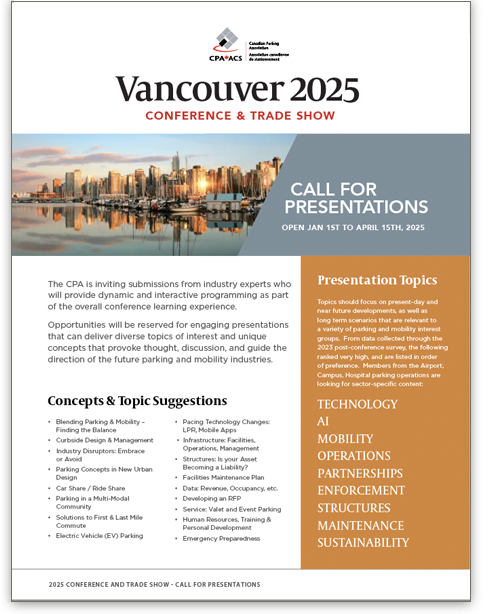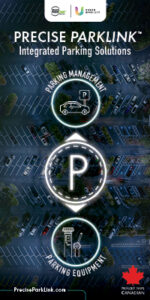By David Poole
In a program involving 13 hospital parkades in Calgary and Red Deer, Alberta Health Services (AHS) upgraded old HID lighting to LED technology, creating an annual cost savings of almost $250,000, while bringing light levels to current standards, and improving the overall quality of illumination.
Illumination in many covered or underground hospital parking lots in Alberta is provided by a mixture of HID (High Intensity Discharge – typically metal halide or high pressure sodium) and fluorescent T8 lighting. Lighting levels varied greatly, from very dim in some cases, to illuminated well beyond current standards for parkade lighting in others. In a retrofit and redesign program, funded by AHS Parking Services department, thirteen parkades were selected for a change-over to LED lighting technology. It should be noted that AHS Parking Services is an ancillary operation and is committed to providing an operation that is sustainable, effective and efficient. With this in mind, the project included a redesign of the lighting, and the use of motion and ambient daylight sensors in order to provide adequate light at all times and further reduce energy consumption and costs.
Project Details
Alberta Health Services engaged a lighting consultant to provide tender documents for the upgraded lighting system and provide pre and post electrical measurements in order to verify the savings. The consultant utilized the current Illuminating Engineering Society of North America (IESNA) recommendations to redesign the parkade lighting. The lighting consultant and AHS worked together to evaluate a number of LED lighting products in order to provide an acceptable number of approved products based on a number of factors including performance, quality, warranty, history, etc.
A total of 4895 fixtures were affected by this project. The simplest upgrade consisted of replacing existing fluorescent T8 tubes with LED tubes of equal length but reduced wattage, using the…
By Ruth Beaman
Technology is transforming parking. New equipment is constantly being introduced: access and revenue control equipment, apps for mobile devices, wayfinding technologies – the list goes on and on. However, as important as technology has come to be, one of the most important aspects of parking management is still stuck in the dark ages. Most owners and operators still haven’t automated their accounting and auditing functions.
In the beginning, parking was a relatively informal and low-tech industry, at least when it came to how it was managed. There’s a common caricature of the early parking operator: cigar in mouth, collecting parking fees and storing them in a cigar box until it was time to go to the bank. As quaint as this image may seem, it’s actually pretty accurate. The problem is, it’s not all that far off today. No, parking operators don’t still keep their money in cigar boxes, at least most don’t. But when it comes to accounting and auditing, most are still living in the past: collecting their receipts, entering parking and revenue data by hand, and hoping reconciliation finds that they’ve ended up with all the money they should. (more…)
By Ariane Sabourin and Brian J. Hall
In the context of environmental impact, the choice of construction products and building systems is significant, and is continuing to grow in importance. In 2013, the building and transportation sectors combined for an estimated 256 Mt or 35% of the total greenhouse gas emissions in Canada. Emission intensive industries accounted for an estimated 76Mt, or 11% (Globe and Mail, January 23, 2016). Selecting a product, brand, or building system will determine the resources used, pollution created, carbon dioxide emitted and waste generated – preference impacts more than just style, function, performance and cost. (more…)
By Ellise Gasner
Times are positively evolving and the focus on sustainability is being embraced by various industries worldwide.
The Parking industry is fortunate that sustainable parking surface alternatives are readily available, easy to incorporate and affordable. Permeable parking has been the norm for our European neighbours for well over two decades and is now becoming widely incorporated throughout North America. (more…)
Parking lots are assets that serve as entrances to city areas and businesses, from commercial stores and plazas to industrial and government buildings. There are two general classes of parking lots, secondary and primary. Secondary being those lots which serve as an access point to a primary business, such as a store or plaza, and primary being those lots which are not attached to any specific business and function solely as a standalone parking garage, such as in a downtown core. However all classes of parking lot serve the same customer, human beings, and the parking lots success depends on a model developed with the human customer in mind. People prefer clean parking lots that feel safe, one that is well maintained physically and structurally, looks appealing in general, and overall is a secure facility in which to leave their car and valuables. There are many ways that new technologies can aid in parking lots, not just to please their human customers, but to also reduce costs, increase revenues, lower liabilities, and improve overall efficiency. Autonomous vehicles, robotics, and artificial intelligence will play an important role in the future of the parking industry.
A well maintained, secure, and safe parking lot is very important to the success of the lot itself as well as the main business it serves. If the lot is classified as a primary parking lot, then it will keep customers coming back and not going to the competition. In the case of secondary parking lots, it is the first impression a customer gets of the business they have ventured to, and the lot is basically an extension of that business. In either case, a happy customer is more likely to spend money and keep coming back, which of course will generate more revenue for the business…
Ticketless parking has become the next stage in the evolution of parking management & revenue capture solutions, with firms around the globe trying their hand at the tech. Initially, ticketless parking aimed to minimize installation & maintenance costs, hedge against complications and frustrations, and reduce the number of staff members required to service the system. However, these goals have become the baseline expectation of the 21st century system. Ticketless, touchless parking is now held to new standards of excellence in the realms of accessibility, efficiency, and intuitive user interface. Enter ZipBy: the ‘VIP’ mobile application & parking management ecosystem.
A subsidiary of TMA Group of Companies Limited, ZipBy is an integrated mobile application & management software designed to provide touchless access control for all parking environments internationally. Through the use of unobtrusive technology, ZipBy can be integrated into any existing Parking System with additional modules related to Pre-Booking, Scan to Pay, Session Transfer, and various other customer-based functions. ZipBy allows users to enter, exit, and pay for parking in a completely touchless, ticketless, and hands-free environment.
Through the mobile application, available for free download via App Store & Google Play, users are prompted to enter their billing & credit card information upon initial profile registration. The user’s mobile device acts as a universal access pass, allowing him to bring that access to any vehicle, and eliminating the need for any license plate registration.
The mobile app runs ‘silently’ in the background with very little battery demand, and therefore does not require the user to manually open the application. The device is recognized using ZipBy’s Bluetooth-based sensory system when drivers approach the ZipBy gate. When the driver approaches the gate and the profile is recognized, the gate opens automatically within seconds. The interaction is entirely hands-free. Upon exiting the garage, the user is again…
Indianapolis, IN – Feb. 22, 2016 – Today, T2’s Chairman and CEO Mike Simmons appointed Adam Blake as the organization’s President. Blake, who currently serves as Chief Operating Officer, will begin this new leadership role immediately with his title shifting to President and COO. Simmons will stay on as Chairman and CEO.
This move comes as T2 has continued to grow, named to both the Indianapolis Business Journal’s Fastest-Growing Companies and the Deloitte Technology Fast 500 lists in 2015. T2 has over 260 employees, offices in Indianapolis and Vancouver and more than 1,100 clients across North America. Blake’s experience in scaling business as well as developing and adopting processes is an asset to the company.
“Adam will have primary responsibility for all customer-related activities,” Simmons said. “He will ensure effective collaboration in the work delivered by our engineering, product management, sales, professional services and support teams.”
A Midwest native and Purdue University graduate, Blake came back to Indy and started at T2 in early 2015. He has worked more than 20 years in the technology industry, most recently at NCR Corporation, a global leader in consumer transaction technologies, where he served as Vice President and General Manager for the Department and Specialty Retail Industry. In one short year at T2, he has been instrumental in improving enterprise processes and customer support.
“I am honored and grateful to be asked to serve in this exciting role because of the team I get to work with—incredibly smart people with unmatched technical and industry knowledge,” Blake said. “We have great opportunities ahead of us.”
As President, Blake will focus on the day-to-day operation of the company, continuing his work to improve the customer experience and product quality. As CEO, Simmons will center his attention on T2’s strategic vision and the company’s further growth.
About T2
Started in…
By Carolyn Krasnow, Ph.D
In recent years, urban planners and community leaders across Canada have turned to “Smart Growth” planning approaches like Complete Streets and New Urbanism to help communities address common challenges associated with downtown planning in the era of the automobile. After decades of urban design focusing on the primacy of the auto, approaches focus on creating communities and streetscapes that provide, among other things, better integration of multi-modal transportation and better walking environments. The point of these planning approaches is to create healthier, less congested and ultimately more livable communities that also foster economic and commercial development.
Arising in the U.S. but quickly becoming international movements, Smart Growth-influenced developments and streetscape upgrades have cropped up throughout Canada. Canadian cities including Mont-Saint-Hilaire in Quebec, Whitehorse in Yukon, and Markham, Ontario have made their communities more walkable and bicycle-friendly, and improved the quality of life for residents. UniverCity in British Columbia and McKenzie Towne in Calgary were created as new communities with sustainable and/or new urbanist principles.
Creating urban environments that have a better balance of transportation modes isn’t as easy as it sounds. Critics of New Urbanism contend that it still accommodates “car culture” more than is desirable, and many people would like to see greatly reduced parking requirements for new developments and cities alike. And given the aging population, decreasing car ownerships trends among younger people, and the rise of car sharing, there is plenty of reason to plan parking with reduced needs in mind. But on the flip side, in most places cars are still the primary form of transportation for most people; not taking them into account adequately can hurt existing businesses and new ones.
A developer we worked with on a transit-oriented development in a vibrant Canadian city came up against this problem as they planned their…






